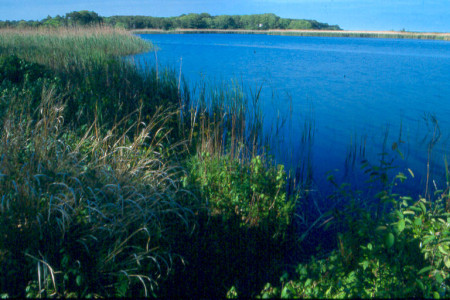Golden Age of the Land Bank
In November 1998, each of 15 towns on Cape Cod voted to approve a 3% surcharge on property taxes to fund acquisition of open space. The Cape Cod Land Bank program was a bold experiment to buy land and save it from the rampant development that threatens the Cape. Cape towns purchased 4,450 acres through the beginning of 2007, when the Land Bank was converted into the Community Preservation Act (CPA) program. This report, including comprehensive and original research conducted by staff of The Compact of Cape Cod Conservation Trusts, Inc., and funded by a grant from the Cape Cod Five Cents Savings Bank Charitable Foundation, documents the significant impact the Land Bank had on preserving critical natural resource lands on the Cape and the need to continue the effort in the CPA era.
Cape Cod Natural History Conference – Land Bank Presentation (PDF)
Town by Town Land Bank Tally (Excel spreadsheet)
To view Land Bank summaries for each town, please click on the links below:
Barnstable Land Bank Summary (PDF)
Bourne Land Bank Summary (PDF)
Brewster Land Bank Summary (PDF)
Chatham Land Bank Summary (PDF)
Dennis Land Bank Summary (PDF)
Eastham Land Bank Summary (PDF)
Falmouth Land Bank Summary (PDF)
Harwich Land Bank Summary (PDF)
Mashpee Land Bank Summary (PDF)
Orleans Land Bank Summary (PDF)
Provincetown Land Bank Summary (PDF)
Sandwich Land Bank Summary (PDF)
Wellfleet Land Bank Summary (PDF)
Yarmouth Land Bank Summary (PDF)
Below, please see the official press release (Aug. 6, 2008) about the Cape Cod Land Bank Era:
FINAL RESULTS OF LAND BANK ERA RELEASED:
Study finds big increase in open space protection, more to do
Thoreau said, “In wildness is the preservation of the World.” On Cape Cod we say, “In protected open space is the preservation of the Wild.”
At its 22nd annual meeting held this week at the Wequassett Inn, The Compact of Cape Cod Conservation Trusts, Inc. released the results of a year-long study of the impact of the Cape Cod Land Bank era, in which all 15 Cape towns purchased open space. The era, called the “Golden Age” for open space protection by Compact Executive Director Mark H. Robinson, ran from November 3, 1998, when voters in each Cape town ratified the state legislation creating the Land Bank, through the beginning of 2007, by which time, most Cape towns had shifted from the Land Bank program to the Community Preservation Act as a different mechanism to accomplish town land use projects.
The Cape Cod Land Bank report was highlighted at the annual meeting by Robinson. He thanked the Cape Cod Five Cents Savings Bank Charitable Foundation for funding the original research. In sum, 15 Cape towns negotiated 233 separate transactions, and acquired 4,450 acres for Land Bank purposes for $213,600,000 through the end of 2007. Owing to grants, subsidies and private donations leveraged by the Land Bank revenues, the total cost to local Land Bank taxpayers was only $145,500,000. The gross cost was $48,000 per acre, impressively low in a time when vacant house lots sold for more than $250,000.
“Cape Codders, born here or drawn here, love their special environment and are willing to pay to defend it,” said Robinson at the meeting, “Scratch any one of us, true to the Cape in spirit, and you will find that we are most at home, out of doors.” He described the overwhelming support of the taxpayers at the 1998 referendum vote on the Land Bank as the “ultimate opinion poll” when citizens voted by a majority of 58% countywide to tax themselves an extra 3% surcharge on property tax to fund the Land Bank.
Robinson listed some of the primary benefits and nagging concerns of the Land Bank effort.
1. Acquisition of open space became a standard operating procedure for the towns, much like repairing roads and buying vehicles. In the past, towns sometimes assembled packages of open space buys for town meeting to consider, but it was spasmodic activity, typically triggered by a particular development threat. The steady source of revenue provided by the Land Bank enabled towns to negotiate from a position of strength. Land bank or open space committees became standing committees of municipal government and acquired expertise in transactions and prioritized their acquisitions.
2. The separate funding source of the Land Bank meant that open space purchases were not in competition with the municipal operating budget. It was not a question of fixing the roof on the school or buying a parcel of land for conservation, but rather deciding which parcel should be bought amongst several land opportunities.
3. Sustained cooperation between local non-profit land trusts and town Land Banks emerged, for the first time in some communities. About 40% of the 233 transactions completed by the towns involved assistance from land trust organizations, typically in negotiating the deal, writing grant applications, raising private funds, organizing voter education campaigns, holding conservation restrictions, or designing and implementing management plans for the Land Bank properties. The archetype was in Falmouth where The 300 Committee, the local land trust, was essentially deputized by the Town to conduct the Land Bank program.
Among the troubling issues that The Compact identified in the Land Bank results were the following:
1. There were anomalies in the way some deeds were recorded. “Every town does everything differently,” said Robinson. Some deeds failed to mention the intended purpose of the land’s use, referring vaguely to Land Bank purposes when the sellers and voters meant conservation use specifically. Less than 20% of the deals had permanent restrictions recorded with the deeds, as envisioned by the legislation. Some failed to record the Town Meeting vote along with the deed. Some failed to index state grant agreements to the deeds in the Registry. “Most of these recording issues were honest errors and can be corrected over time,” said Robinson. “Our study identifies most of them and I will encourage town open space leaders to work back through them.”
2. Related to this issue is the more alarming one facing town citizens in the future: the substitution of one valid Land Bank land use for another one. “If the Town Meeting vote and the deed simply reference general Land Bank purposes, then towns may feel free to adapt a forest parcel to a community garden or a ballfield, or clear cut the forest for a scenic vista, all of which are allowed under Land Bank rules,” Robinson noted. “I know some Selectmen, Town Managers and Town Counsels who specifically urged this ‘flexibility’ in intended uses. But I also know most voters expect that a natural area acquired by the Land Bank be kept in a natural state.” Provincetown was the only town that recorded stand-alone conservation restrictions over all of its Land Bank purchases, requiring that the land be used solely for conservation forever.
3. Towns entered the Land Bank Era expecting a 20-year run. When the time came to decide whether to keep the Land Bank or convert to the Community Preservation Act in 2006, it was obvious that most towns would convert to CPA in order to share in matching state funds, while enabling important affordable housing and historic preservation projects also be funded through the continuing 3% tax surcharge. “The necessary evolution to CPA meant that almost half the towns left open space money on the table,” said Robinson. Some towns had borrowed against 20 years worth of Land Bank revenues by FY2007, but others saw their Land Bank account subsumed into the CPA fund to be split for other uses.
Going forward, The Compact believes the way to keep faith with the 1998 voters who approved a 20-year Land Bank program is to maintain the level of effort in preserving open space envisioned by the Land Bank within the new structure of the CPA. “Shifting from land Bank to CPA did not mean we were done with open space protection and could turn exclusively to other social issues,” said Robinson. “It meant that the beginning we had made on land protection using one funding source would be continued with a different one. Otherwise, it could be perceived as a bait-and-switch issues with the voters.”
The Compact found during the Land Bank era that open space protection generally kept pace with acres of land developed on the Cape. Initial tracking of open space purchases through CPA, however, show that level of effort dropping. The county planning goal, as adopted in the Regional Policy Plan, is to continue to preserve one acre for every new acre developed in order to preserve the quality of the Cape’s natural resources.
One way to increase new open space purchases is to encourage towns to make more consistent use of outside subsidies, especially the state’s LAND grant program, recently replenished by the 2008 State Environmental Bond signed by Governor Patrick. The LAND grants (formerly called State Self Help) can provide up to 52% of purchase price or $500,000, whichever is less, for a town conservation acquisition. These grants provided more than $7.3 million in supplemental funding for Land Bank purchases, but most towns ignored it in any given year. Wellfleet, however, was best able to stretch its Land Bank dollars with this state grant source, collecting almost $1.5 million towards its $4.5 million total purchase costs over seven years. “Cape LAND applications are almost always funded, owing to our unique habitats and sole source aquifer,” noted Robinson. “Some towns don’t like the strings attached to state grants. Well, yes, the state grant requires that the town conservation land stay in conservation and be open to the public. That’s not a thing to be feared.”


